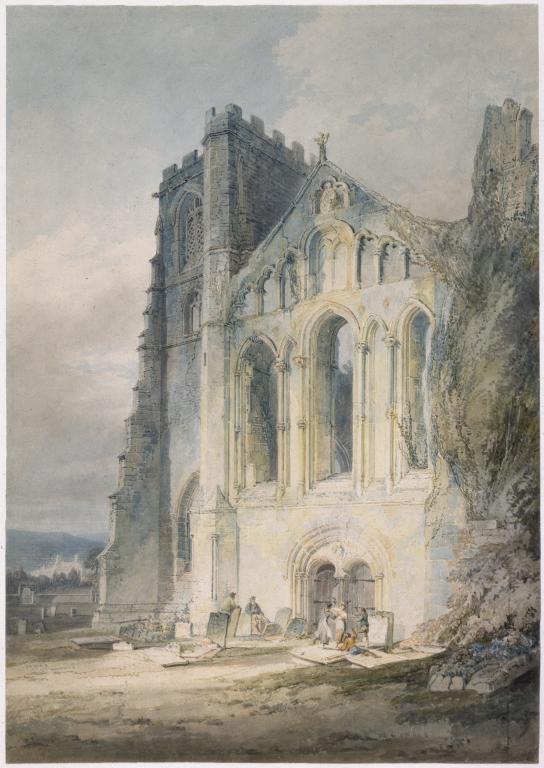Joseph Mallord William Turner Llandaff: The West Front of the Cathedral 1795-6
Joseph Mallord William Turner,
Llandaff: The West Front of the Cathedral
1795-6
Joseph Mallord William Turner 1775–1851
Llandaff: The West Front of the Cathedral 1795–6
D00686
Turner Bequest XXVIII A
Turner Bequest XXVIII A
Pencil and watercolour on white wove paper, 356 x 255 mm
Stamped in black ‘XXVIII – A’ bottom right
Stamped in black ‘XXVIII – A’ bottom right
Accepted by the nation as part of the Turner Bequest 1856
Exhibition history
1796
Royal Academy, London 1796 (701).
1904
National Gallery, London, various dates to at least 1904 (795, as ‘Llandaff Cathedral (early)’).
1975
Turner in the British Museum: Drawings and Watercolours, Department of Prints and Drawings, British Museum, London, May 1975–February 1976 (10, reproduced).
1977
Turner Watercolors: An Exhibition of Works Loaned by The Trustees of the British Museum, International Exhibitions Foundation tour, Cleveland Museum of Art, September–November 1977, Detroit Institute of Arts, December 1977–February 1978, Philadelphia Museum of Art, March–April 1978 (3, reproduced).
1984
Turner in Wales, Mostyn Art Gallery, Llandudno, July–September 1984, Glynn Vivian Art Gallery and Museum, Swansea, September–November 1984 (38, reproduced in colour).
1988
Young Turner: Early Work to 1800: Watercolours and Drawings from the Turner Bequest 1787–1800, Tate Gallery, London, January–March 1988 (18, reproduced).
References
1904
E.T. Cook and Alexander Wedderburn eds., Library Edition: The Works of John Ruskin: Volume XIII: Turner: The Harbours of England; Catalogues and Notes, London 1904, p.641 no.795, as ‘Llandaff Cathedral (early)’.
1909
A.J. Finberg, A Complete Inventory of the Drawings of the Turner Bequest, London 1909, vol.I, p.56, XXVIII A, as ‘Llandaff Cathedral’. c.1796.
1910
Alexander J. Finberg, Turner’s Sketches and Drawings, London 1910, pp.23, 29–30, 31.
1975
Elis Jenkins, ‘J.M.W. Turner in Glamorgan’, Glamorgan Historian, vol.2, 1975, p.57 pl.1, p.66.
1979
Andrew Wilton, J.M.W. Turner: His Life and Work, Fribourg 1979, pp.43, 315 no.143, pl.24.
Technique and condition
This is a pencil and watercolour composition on off-white wove Whatman paper. The pencil under-drawing in this image is minimal and most of the detail, such as the lettering on the tombstone, has been painted directly in watercolour. The arches have pencilled outlines, but most of the modelling for the columns has been done with a single graded wash applied carefully and locally: that is, a wash using a single colour swept out to paler tones with water. Many details are depicted by leaving reserves of white paper between the washes, as has been done for many of the building blocks. The dancers’ costumes have been depicted in very fine detail, though the faces are minimally depicted.
A very limited palette has been used for most of the subject, two shades of ochre, indigo (probably), green mixed from indigo and a yellow pigment for the foreground, with a slightly wider range of colours for the costumes. Unusually for Turner, some grey washes are made from black pigment only, in contrast to his usual practice of mixing blue and red together. Here, he has not used any pure red pigment, which means it would not have been set out on his palette ready for immediate use in a mixture.
Helen Evans
October 2008
Revised by Joyce Townsend
February 2011
How to cite
Helen Evans, 'Technique and Condition', October 2008, revised by Joyce Townsend, February 2011, in Andrew Wilton, ‘Llandaff: The West Front of the Cathedral 1795–6 by Joseph Mallord William Turner’, catalogue entry, April 2012, in David Blayney Brown (ed.), J.M.W. Turner: Sketchbooks, Drawings and Watercolours, Tate Research Publication, December 2012, https://wwwThis watercolour is based on a pencil drawing in the South Wales sketchbook (Tate D00556; Turner Bequest XXVI 4). Commissioned by Dr Matthews (see the list of ‘Order’d Drawings’ near the front of the South Wales book, Tate D40557), it was probably the work shown at the Royal Academy in 1796 (701). For a possible source for the dancing figures in the foreground see the South Wales view of the gateway of the Bishop’s Palace at St David’s (Tate D00593; Turner Bequest XXVI 39).
Finberg dismisses this watercolour as ‘merely the work of a clever and skilful topographical draughtsman ... When the artist has told us as clearly and precisely as possible the exact shape of every object from his chosen point of view, we feel that he has done all that he set out to do, and all that we can reasonably demand of him. Then these objects are left standing side by side in relative independence of each other and of us; they have no necessary connection one with the other ... Their only bond of union is the abstract one of space. The whole effect is of something severed from direct experience; the objects have an unreal air of permanence and immutability, with something of the intellectual coldness and aloofness of a diagram or mathematical symbol.’1
These strictures are prompted by a comparison with the watercolour of the Interior of Ewenny Priory that Turner exhibited in 1797 (National Museum Wales, Cardiff);2 and see the Smaller South Wales sketchbook, Tate D00472; Turner Bequest XXV 11), which is a technically more sophisticated work But they do less than justice to the expressive subtlety of Turner’s conception in the Llandaff. The figures of old men gossiping and young people dancing to a fiddle, though deliberately introduced on a small scale to emphasise the majestic proportions of the cathedral, are carefully devised to point up the themes of the subject: the passing of time, youth, age, and the contrast between antiquity and modernity, the spiritual and the mundane.
Verso:
Blank; not stamped.
Andrew Wilton
April 2012
How to cite
Andrew Wilton, ‘Llandaff: The West Front of the Cathedral 1795–6 by Joseph Mallord William Turner’, catalogue entry, April 2012, in David Blayney Brown (ed.), J.M.W. Turner: Sketchbooks, Drawings and Watercolours, Tate Research Publication, December 2012, https://www

